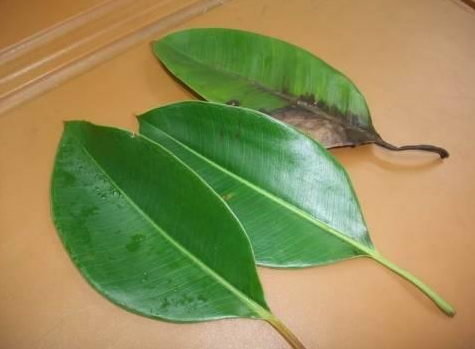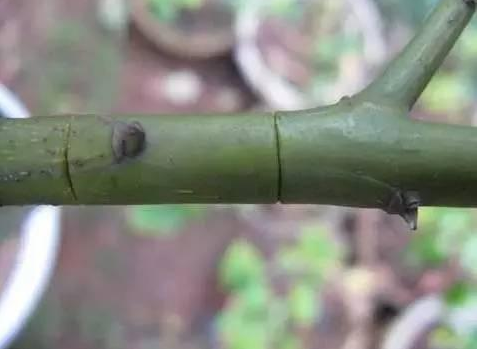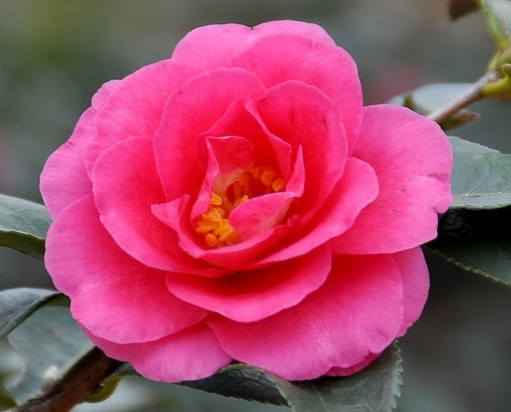How do rubber trees propagate with leaves what is the cutting temperature?
Speaking of this rubber tree, this is a lot of people like farming, this rubber tree is super green, good-looking, let's see how rubber trees reproduce with leaves? What is the cutting temperature of rubber trees:

How rubber trees reproduce with their leaves:
1. The timing of cutting and the selection of leaves:
To know that rubber trees are tropical plants, the best cutting temperature is above 20 degrees, too low temperature will impress sprouting and rooting, of course, the temperature is not suitable for more than 32 degrees.
Wait for the weather to warm, the temperature is stable and then carry on the appropriate cutting, the selected leaves should be healthy, free of diseases and insect pests, preferably the thick and strong leaves at the bottom.
2. Selection of cutting methods.
There are also many propagation methods for leaf cuttings, and the three most effective ones are rooting with river sand, perlite or hydroponics.
All three methods are very easy to promote rooting, but after the root system grows to 3 to 5 centimeters, it needs to be transplanted into potted soil.
3. Pay attention to hydroponics
It is also better to take root by hydroponic culture of the cut rubber tree leaves. Prepare pure water or dry tap water for 2 or 3 days, thick and robust rubber tree leaves together with petioles go in, it is best to soak the petiole in about 5 centimeters. It doesn't matter if the leaves are not stained with water. Before rooting, the water is usually changed once every 3 days to keep the water active.
4. Cutting with soil
The best soil is sandy soil, the soil is loose, breathable and well drained. The scissors for pruning the leaves of rubber trees should be sharp, and it is best to trim them after disinfection.
The leaves are inserted obliquely in the soil about 3 cm, keep the soil moist without stagnant water, keep it in a warm and shady place, keep the environment ventilated, and don't bask in the sun first.
5. Pay attention to leaf cutting.
Although the leaf cutting rubber tree is relatively easy to succeed, but should be careful not to lose patience, sometimes maintenance for a month or two, there is no change, do not worry, flower breeding requires full patience.
If the temperature and humidity are not enough, leaf cutting is also more difficult to succeed. Flower friends in the southern region have natural advantages, but if the temperature and humidity is not enough, you can put on a plastic bag and open the bag for ventilation when the temperature increases at noon.
What is the temperature of rubber tree cuttings:
Rubber tree cuttings are generally more suitable for more than 20 degrees.
This is the end of the introduction to the method of leaf reproduction of rubber trees, and the temperature of this cutting should also be paid attention to.
How to Cuttage Hevea brasiliensis
The low survival rate of cutting propagation of rubber trees makes many friends have a great headache, so how to reproduce rubber trees? Next, Xiaoqi will talk about the propagation methods and cutting propagation skills of this rubber tree, so that we can improve the success rate of rubber tree cutting propagation.
I. Propagation methods of rubber trees
Rubber trees are generally propagated by cuttings and striping. During the growing period of spring and summer, the middle and upper biennial robust branches should be selected as cuttings. Cut in autumn, select the Lignified branches of the current year as cuttings. As long as the bed temperature can be kept above 15 ℃, the cutting time is unlimited. In addition to cutting in the bed, water cutting can also be carried out. From April to May, take the long branches of the same year's 15cm, remove the lower leaves, wait for the cut to dry, insert them into a glass bottle filled with water, put them in the place of scattered light, change the water once a week, and take root after about one month.
Second, cutting propagation techniques of rubber trees.
1. Cutting time: the cutting time is high in summer, and the air humidity is relatively high. Generally, it is appropriate to cut cuttings from the end of June to the end of July.
two。 Selection of cuttings: the quality of cuttings directly affects the survival rate of cuttings, so it is necessary to strictly select cuttings to be cut, generally choose sturdy branches that grow every other year and are completely lignified at the end of the surface as cuttings. This kind of branch has sufficient nutrients, so it is easy to take root and has strong disease resistance. On the other hand, it is not easy to take root if you have chosen ten woody strips and it is difficult to survive, while the branches that are too tender are easy to rot.
3. Preparation before cutting: alcohol lamp (or a cup of boiling water) sterilized cans (boiled with water), one cutting bed, can be replaced by a wooden box (the length of the wooden box depends on the number of spikes, the depth is 15 cm), the bottom of the wooden box is evenly drilled into small holes by carpentry to facilitate water penetration. Lay 5 cm thick coarse river sand (rinse it with water), cover it with 10 cm thick fine river sand (also need to be washed with water), pour enough water with a spray can, and make a cover with plastic sheet, iron wire or wood square. its height is 35ml and 40cm, which is slightly longer than the wooden box used in the cutting bed.
4. The operation method of cutting:
a. Quickly cut the selected strong branches into sections of 12-15 cm and quickly burn the cut place on the alcohol lamp (or scald it in boiling water). Burning (scalding) time: the white sap of the rubber tree does not continue to overflow (note: this is the key to the survival of cuttings, the purpose of burning or scalding the cutting place is twofold, one is that the sap can not continue to overflow after burning or scalding. So as to ensure that there are sufficient nutrients and water in the cuttings for its survival. The second is to prevent the sand or air bacteria from the cutting bed from infecting the wound and causing decay)
b. Remove the extra leaves and there are only two leaves left. Put it in a canned bottle and fill it with fresh water (the water should be dried 3 days in advance) and put it in a sunny place. Give the water to the leaf dough 3 times a day, lower the temperature, and change the bottle of water every 4 days. In the high temperature and sunny weather, the cuttings can produce white roots in 10 days.
c. When the root grows to 3mi 5mm long, it can be implanted into a wooden box full of river sand, with a depth of 7mi 9cm, which should be inserted directly. After spraying enough water, cover with plastic cover and spray clean water once in the morning and evening every day.
D.10 after 15 days, the cuttings can be transplanted into a flowerpot in plain soil and placed in a shady place. Half a month later, the cuttings can be rooted, the extra axillary buds can be removed, two can be left, and some thin fat water can be poured, gradually moving from the shade to the full light.
The above is the introduction of rubber tree propagation methods and cutting propagation skills. If you want to improve the success rate of rubber tree cutting propagation, you should read it carefully.
How to reproduce rubber trees, how to cut rubber tree leaves / soil / water cutting can be
Rubber tree belongs to an evergreen tree, and its reproduction mode is special compared with other plants. For example, in common cutting propagation, both cuttings and single buds can be used, and there are many options for water and soil cuttings. so how do rubber trees reproduce? How to cut the leaves of rubber trees? Let's take a look at the breeding methods of rubber trees.
How do rubber trees reproduce?
According to the statistics of flower friends' breeding experience, the main propagation methods that rubber trees can use are cutting and striping, and there are many forms of cutting, which are divided into branch cuttings and leaf cuttings according to cuttings. According to the choice of matrix, there are water insertion and soil insertion, which are introduced in detail below.
Propagation methods of rubber trees
I. Cuttage propagation of rubber tree
Make cuttings
1. Branch cutting
⑴, time. Branch cutting time is generally chosen in April-May or September, because at this time it is easier to control the temperature above 20 degrees.
⑵, select the insert. Select the sturdy semi-lignified branches from the rubber tree, cut them off and divide them into sections of 12-15 cm cuttings, seal the cut with glue or plant ash to avoid excessive milk flow, and then leave it in a cool place to dry.
2. How to cut the leaves of rubber trees
⑴, time selection. The time is also chosen when the spring temperature is higher than 20 degrees, in order to facilitate rooting.
⑵, select leaves. Choose the leaves that are not strong, thick and glossy from the rubber tree, cut the leaves together with the petiole, then wrap the wound in plant ash, wait until the milk is no longer flowing, disinfect with potassium permanganate solution, and then leave it in a cool place to dry.
Start cutting
1. Soil cutting propagation
⑴, the production of matrix. The substrate is made of river sand, perlite, etc., and properly watered on the surface of the substrate to keep the surface moist and facilitate cutting behind.
After ⑵ and substrate are made, how do rubber trees reproduce? Insert the branches or leaves into the substrate, then pour water through, then keep the soil moist but not stagnant, keep the temperature at 18-25 ℃, often spray water on the soil, and then leave it in a cool place for 2-3 weeks to take root, and increase light after budding.
2. Water insertion propagation
⑴, leaf water insertion. Take out the dried and sterilized leaves, put the petiole into the water, keep the petiole 5 cm in the water, and the leaf part should be exposed to the water, and then change the water every 3-5 days. It takes 1-2 days to change the water after rooting, and transplanting can be carried out after 50 days.
⑵, branch water insertion. Take out the branch cut from the rubber tree, insert the lower part of the branch into the water, the part of the branch in the water is 1/3 of the branch, then change the water every 3 days, wait for two months to take root, and then transplant into the basin.
2. Striping propagation
1. Time
It is generally appropriate to use the pressing in June, because after pressing, it will take root in July-August, and then transplant to other places can smoothly adapt to the new environment and prepare for the winter ahead of time.
2. Crimping method
How do rubber trees reproduce when striping is used? Here is the main introduction of high-altitude pressure strips. The 2-year-old strong and substantial branches were selected from the plant, and the width of 1CM was annular peeled at the predetermined position, then smeared with 30-50ppm naphthalene acetic acid solution.
Wrap the wound with wet soil in a plastic bag, fasten the upper and lower sides of the plastic bag film tightly, pay attention to keep the soil in the belt moist, and then wait 3-4 weeks before it can take root, and when it takes root, it can be cut off and transplanted, and then it can be managed normally according to the breeding method of rubber trees.
- Prev

How long does it take for roses to be striped and propagated?
To talk about this rose, this is a lot of people like to breed, this rose can also be reproduced, let's see how to achieve rose striping reproduction? How long does it take to press the rose to root: how to achieve the propagation of the rose: select the propagation branches, of course, choose the woody rose branches that have grown for a year or two, as shown in the following figure.
- Next

What if the camellias lose their leaves? is it suitable to grow indoors?
Camellia, which is the one in bloom of tea, feels a little sad when I hear it, because there is a novel called Camellia Girl. This is a tragedy. Let's see what to do when camellias lose their leaves. Are camellias suitable for growing indoors: what to do when camellias lose their leaves: first, the pot soil is too dry or too wet
Related
- Fuxing push coffee new agricultural production and marketing class: lack of small-scale processing plants
- Jujube rice field leisure farm deep ploughing Yilan for five years to create a space for organic food and play
- Nongyu Farm-A trial of organic papaya for brave women with advanced technology
- Four points for attention in the prevention and control of diseases and insect pests of edible fungi
- How to add nutrient solution to Edible Fungi
- Is there any good way to control edible fungus mites?
- Open Inoculation Technology of Edible Fungi
- Is there any clever way to use fertilizer for edible fungus in winter?
- What agents are used to kill the pathogens of edible fungi in the mushroom shed?
- Rapid drying of Edible Fungi

